 |
 |
|
Bushfires
Tasmania forms part of the driest and most fire-hazardous continent in the world and our fire seasons are very irregular in intensity. Higher rainfalls in certain areas and the fertility of the soil contribute heavier concentrations of ground fuels than in other parts of Australia. When the right conditions prevail, fires can become uncontrollable and large conflagrations occur. Tasmania has faced a series of devastating fires from early settlement in 1803. The new settlers were not used to the summer conditions which caused fire to spread quickly. As early as 1854 a Bush Fires Act aimed 'to guard against damage by fire in certain months of the year', by preventing fires being lit and escaping on to another person's property. This was the result of a large fire which caused havoc when it 'ravaged' the outskirts of Hobart early that year. Despite the Act, Tasmania has faced many devastating fires since 1854. The worst were in 1854, 1897–98, 1913–15, 1926–27, 1933–34, 1940–42, 1960–61 and 1967. In 1895 eleven houses were destroyed at Dundas on the west coast, and in 1897–98 an area almost the same as the 1967 fires was burnt when the 'Black Friday' fire spread rapidly through the south, destroying farms and forests. It covered the area from the lower Midlands and the Channel District to Port Arthur (destroying part of the Penitentiary), the Derwent and Huon Valleys, as far as Esperance and Cygnet. The fire in late December 1933 to January 1934 threatened the whole of the Derwent Valley and 300 volunteers were rushed to fight it. Perhaps the most devastating were the bushfires of 1967, a disaster of enormous magnitude in southern Tasmania, the blackest day in the history of the state.
Before the 1930s there was very little organisation to fight bush fires in Tasmania. The dangers from bush fires were well recognised but nothing much had been done to form an organisation capable of fighting them. However, the 1967 disaster led to the formation of the Rural Fires Board and eventually the Tasmania Fire Service, a splendid fire-fighting organisation. (See also Fire Brigades.) Further reading: R McNeice, Helmets and hatchets, Hobart, 1983; Men of fire, Hobart, 1987; The New Norfolk volunteer urban fire brigade, Hobart, 1989; With skill and dedication, Hobart, 1993; and Knapsack heroes, Hobart, 1991. Roger McNeice
|
Copyright 2006, Centre for Tasmanian Historical Studies |

